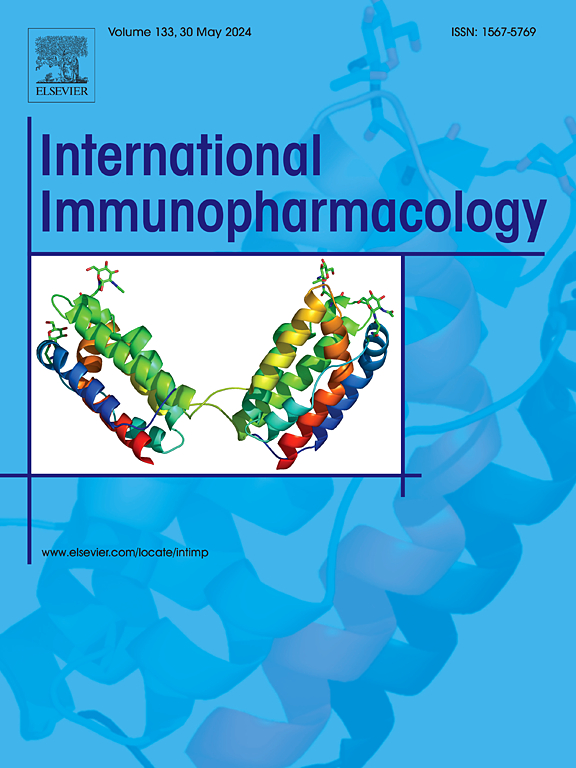fc γ - ri通过上调树突状细胞相关基因在衣原体呼吸道感染的免疫应答中发挥促炎作用。
IF 4.7
2区 医学
Q2 IMMUNOLOGY
引用次数: 0
摘要
背景:fc γ - ri是一种关键的细胞表面受体,参与多种免疫反应,在许多免疫细胞中普遍表达。然而,其在细胞内细菌感染中的作用仍未得到充分研究。方法:以野生型(WT)和fc γ γ ri敲除型(FcγRI- ko)小鼠为研究对象,经鼻灌胃接种一定剂量的毒舌草。采集肺组织进行转录组测序,流式细胞术验证生物信息学免疫浸润分析。对差异表达的dc相关基因进行基因本体和京都基因与基因组百科分析,以阐明其在感染过程中的功能。构建PPI网络以确定关键基因,并利用qPCR确认其表达变化。此外,我们比较了WT和fc γ γ - ri - ko小鼠感染后的体重、肺衣原体负荷和病理变化,以评估fc γ - ri通过基因调控对炎症的影响。最后,我们构建了mRNA-miRNA-lncRNA网络,进一步探讨了fc γ - ri在muridarum感染中的分子机制。结果:Post-C。感染后,FcγRI-KO小鼠DC浸润和成熟明显减少,肺组织中共刺激分子(CD40, CD80, CD86)下调。差异基因分析确定了26个差异表达的DC相关基因,这些基因与DC增殖、迁移和炎症反应有关。KEGG分析显示它们与关键免疫通路密切相关。PPI网络描绘了两个模块,关键簇1中的前六个基因(Ccl4, Il6, Ccl3, Ptgs2, Il 1α, Il7)在FcγRI-KO小鼠中显著下调。构建了一个包含12个mirna和37个lncrna的ceRNA网络,调控4个关键基因(Ptgs2, Il1α, Il6, Il7)。结论:在muridarum呼吸道感染中,FcγRI促进DC浸润和成熟,上调6个促炎基因(Ccl4、Il6、Ccl3、Ptgs2、Il1α、Il7),并表现出促炎作用。制定了一个关键的ceRNA网络来揭示潜在的分子机制。本文章由计算机程序翻译,如有差异,请以英文原文为准。
FcγRI plays a pro-inflammatory role in the immune response to Chlamydia respiratory infection by upregulating dendritic cell-related genes
Background
FcγRI, a pivotal cell surface receptor, is implicated in diverse immune responses and is ubiquitously expressed on numerous immune cells. However, its role in intracellular bacterial infections remains understudied.
Methods
Wild-type (WT) and FcγRI knockout (FcγRI-KO) mice were inoculated intranasally with a specific dose of C. muridarum. Lung tissues were harvested for transcriptome sequencing, and flow cytometry was employed to validate bioinformatics immune infiltration analysis. Differentially expressed DC-associated genes were subjected to Gene Ontology and Kyoto Encyclopedia of Genes and Genomes analyses to elucidate their functions during infection. A PPI network was constructed to pinpoint crucial genes, and qPCR was utilized to confirm their expression changes. Additionally, we compared body weight, lung Chlamydia load, and pathological alterations between WT and FcγRI-KO mice post-infection to assess the effect of FcγRI on inflammation via gene regulation. Lastly, an mRNA-miRNA-lncRNA network was formulated to further probe the molecular mechanisms of FcγRI in C. muridarum infection.
Results
Post-C. muridarum infection, FcγRI-KO mice exhibited a notable decrease in DC infiltration and maturation, along with downregulated co-stimulatory molecules (CD40, CD80, CD86) in lung tissues. Differential gene analysis identified 26 differentially expressed DC-related genes implicated in DC proliferation, migration, and inflammatory responses. KEGG analysis revealed their close association with key immune pathways. The PPI network delineated two modules, with the top six genes in the pivotal cluster 1 (Ccl4, Il6, Ccl3, Ptgs2, Il 1α, Il7) being significantly downregulated in FcγRI-KO mice. A ceRNA network encompassing 12 miRNAs and 37 lncRNAs regulating four key genes (Ptgs2, Il1α, Il6, Il7) was also constructed.
Conclusions
In C. muridarum respiratory infections, FcγRI facilitates DC infiltration and maturation, upregulates six pro-inflammatory genes (Ccl4, Il6, Ccl3, Ptgs2, Il1α, Il7), and exhibits a pro-inflammatory role. A key ceRNA network was formulated to unravel the underlying molecular mechanisms.
求助全文
通过发布文献求助,成功后即可免费获取论文全文。
去求助
来源期刊
CiteScore
8.40
自引率
3.60%
发文量
935
审稿时长
53 days
期刊介绍:
International Immunopharmacology is the primary vehicle for the publication of original research papers pertinent to the overlapping areas of immunology, pharmacology, cytokine biology, immunotherapy, immunopathology and immunotoxicology. Review articles that encompass these subjects are also welcome.
The subject material appropriate for submission includes:
• Clinical studies employing immunotherapy of any type including the use of: bacterial and chemical agents; thymic hormones, interferon, lymphokines, etc., in transplantation and diseases such as cancer, immunodeficiency, chronic infection and allergic, inflammatory or autoimmune disorders.
• Studies on the mechanisms of action of these agents for specific parameters of immune competence as well as the overall clinical state.
• Pre-clinical animal studies and in vitro studies on mechanisms of action with immunopotentiators, immunomodulators, immunoadjuvants and other pharmacological agents active on cells participating in immune or allergic responses.
• Pharmacological compounds, microbial products and toxicological agents that affect the lymphoid system, and their mechanisms of action.
• Agents that activate genes or modify transcription and translation within the immune response.
• Substances activated, generated, or released through immunologic or related pathways that are pharmacologically active.
• Production, function and regulation of cytokines and their receptors.
• Classical pharmacological studies on the effects of chemokines and bioactive factors released during immunological reactions.

 求助内容:
求助内容: 应助结果提醒方式:
应助结果提醒方式:


